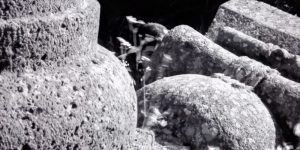ART BLOG – GROUNDWORK SUNDAY 10/06/2018
The beginning of June saw the end of the Steve McQueen screening by the Groundwork programme at CAST. Thankfully it also marked the opening of an equally emotive film by Belgium born former architect Francis Alÿs.
Another triumph in sound, The Silence of Ani, was commissioned for the Istanbul Biennial in 2015. Thankfully this masterpiece of black & white filmmaking has finally made its way to Cornwall for its first UK presentation. The mesmerising orchestral effect of the bird calls coupled with the graceful choreography of the children and the stunning cinematography is astounding. The rich tapestry which was technically woven by Alÿs and his team blends these creative elements to deliver a visual and auditory feast which compels you to watch the thirteen-minute film again and again.
The silence of Ani, was shot on location amongst the ruins of an ancient Armenian city, Ani, near the border of Turkey. Long since declined from its 13th-century majesty, not much much remains of its legendary 101 churches. In the film, we see the city brought back to life by bird calls, created by Duduks – ancient double-reed woodwind flutes (also on show with the film). These bird calling devices once used for hunting, play a particular relevance to the film’s metaphor of hope to readdress the more recent Armenian genocide in the area.
Alÿs worked with a composer to create a musical score for the bird calls which went through 3 different iterations. The final version was rewritten once the children were onsite and the choreographic and locational restrictions were taken into account.
Until recently Ani was used as s military site. Alÿs and his team had permission to shoot for a mere five days amongst the ruins. Unfortunately, they were hampered by bad weather during the first two days on location, so shooting time was cut down dramatically to just a few days.
Although the film was originally planned to have documentary overtones, collaboration with a composer and choreographer has given the film structure a more fictitious narrative than most of Alÿs’ other work. The sense of fantasy, despite its political overtones, was born out of a necessity to choreograph the bird calls with the abstract nature of the children movements. This unexpected evolution was something Alys did not predict but which he believes has brought its own reward.
It was Alÿs’ political statements in both When Faith Moves Mountains, shot in Lima, Peru, 2002, along with The Green Line, Jerusalem 2004, which caught the attention of the 2015 Istanbul Biennial commissioners. Similarly, as a consequence, his work in Ani opened the doors of possibility to allow him to work on his latest project with the Kurdish refugee camps in Iraq, Colour Matching, Mosul, Iraq 2016 and Children’s Games 16 / Hopscotch, Sharia Refugee Camp, Iraq 2016.

Comments are closed.